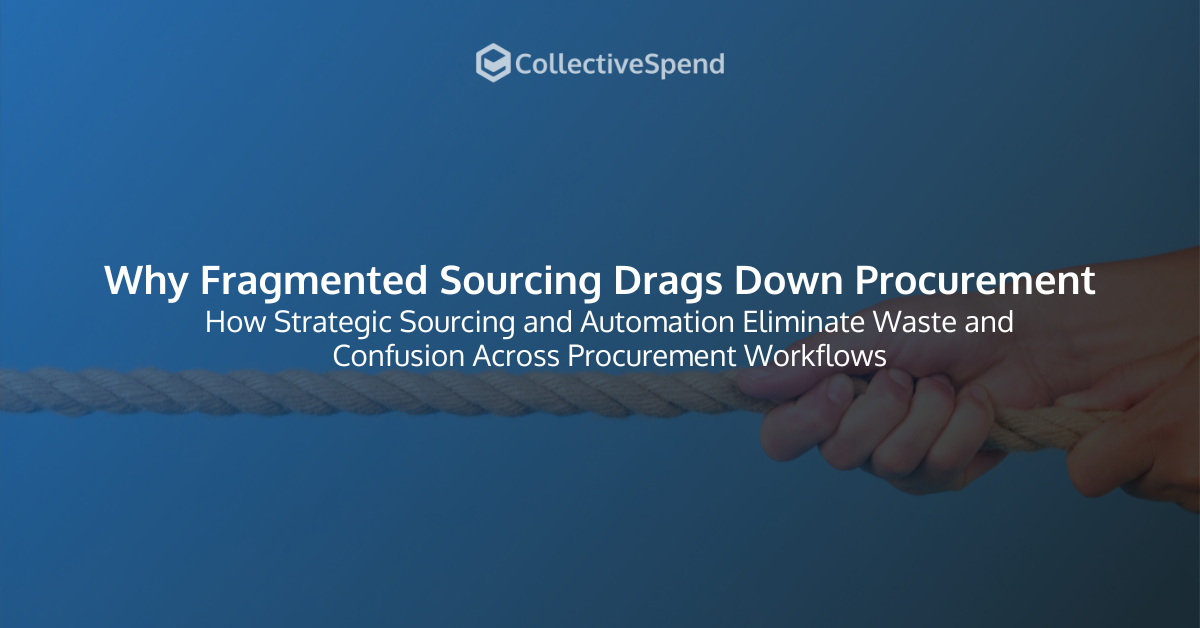Fragmented sourcing might not raise alarms at first, but over time, it slowly chips away at procurement performance. It causes confusion, slows down processes, and introduces costly errors that could have been avoided. When the sourcing process is broken into silos and inconsistent across departments, we miss opportunities for better terms, waste time managing supplier issues, and risk compliance gaps. Smart sourcing strategies are the fix, but first we need clarity on what’s actually going wrong.
What Fragmented Sourcing Really Looks Like
In a typical procurement process, teams rely on a shared platform, communal insight, and streamlined workflows. When sourcing is fragmented, those pieces fall out of sync. One team may deal with suppliers directly through email while another sticks to the e-procurement platform. Approvals are skipped. Contracts go unchecked. Communication feels disconnected because systems and expectations are inconsistent.
This kind of disjointed operation encourages rogue spending. Employees turn to quick one-time suppliers for spot buys rather than using pre-approved vendors. Over time, this drives up non-contracted purchases that are hard to monitor and harder to measure. Without a central process, we end up with duplicate efforts, missed volume discounts, and suppliers who slip through performance checks.
The more fractured the process, the harder it is to keep track. Without a centralized tool, procurement has to rely on fragmented data sources, low visibility into vendor history, and no clear way to know who’s truly controlling cost or risk. That inconsistency doesn’t just hurt day-to-day tasks; it creates a ripple effect across finance, operations, and supply chain planning.
Hidden Costs and Operational Strain
Fragmented sourcing doesn’t just lead to confusion. It directly hits the budget. Without structured sourcing, the same item might be purchased at five different prices from five different suppliers. These mismatches in cost stack up quickly and create real gaps in projected versus actual spend.
We also see performance issues ripple out across the supplier network. When vendors aren’t managed consistently, follow-through breaks down. Delivery timelines suffer. Quality declines. Internal teams become frustrated when orders don’t arrive as expected, leading to delays that impact production or service delivery.
Finance teams, in particular, feel the strain. Without proper tracking, ROI becomes hard to define. Cost leakage from unmanaged spend or missed early payment discounts flies under the radar. When indirect procurement lacks structure, the financial story becomes messy, nothing ties together accurately, making forecasting and budget planning difficult.
Strengthening Control Through Strategic Sourcing
This is where sourcing strategies make a real difference. We’re not just talking about choosing preferred suppliers, we’re shifting the whole approach. Procurement works better when supplier management, approvals, and data flow together.
A clear strategy starts by consolidating suppliers. By grouping categories and reducing vendor sprawl, procurement gains leverage to negotiate better terms and unlock value. Supplier consolidation cuts unnecessary complexity and gives visibility into performance trends. Strategic partnerships form more easily when vendor relationships aren’t managed in isolation.
It also helps when internal workflows match the structure we want from our sourcing partnerships. Standardized approvals and clear sourcing policies mean procurement teams can work with confidence. These policies create alignment across departments and reduce last-minute spot buys that throw off the plan.
Procurement automation supports all of this. Smart tools suggest vendors, enforce approval rules, and lock in sourcing behavior. This creates a cleaner process that’s easier for teams to follow and less prone to deviation. Instead of focusing on operational firefighting, procurement can focus on strategic categories and long-term planning.
CollectiveSpend’s sourcing strategies combine supplier consolidation with AI-driven spend analytics and procurement automation, helping organizations streamline category management and reduce risk in all purchasing activities.
How Data Brings Sourcing Back Into Focus
Fragmentation doesn’t happen all at once. It often builds quietly as teams react to shifting demands, tight timelines, or what feels like faster solutions. Spend data helps us spot those issues before they turn into ongoing problems.
Indirect spend analytics shine a light on these blind spots. They help us see where non-contracted purchases keep recurring, which teams are sourcing outside the workflow, and where supplier duplication is leading to pricing variance. With the right tech, we don’t have to audit spreadsheets or guess at inconsistencies. We get dashboards that show the real picture.
Dashboards aren’t just for visibility. They guide behavior. When sourcing decisions are clearly tracked, teams become more mindful of which vendors they use and why. Procurement gains a stronger voice at the table and can present clean data to finance and leadership that explains where spend is going and what needs fixing.
Beyond insight, the next step is scale. Fragmentation is harder to fix when solutions depend on manual intervention. That’s why scalable procurement tools matter. When automated sourcing, contract management, and supplier data live in one place, the fix is no longer reactive. It becomes built into the way we work every day.
Turn Chaos Into Clarity With Smarter Sourcing
When sourcing activity runs in every direction, it’s hard to manage cost, risk, and performance in any consistent way. Fragmented sourcing might start with small shortcuts, but over time it leads to bigger problems, from spend leakage to supplier mismanagement.
Bringing it back into focus means slowing down the chaos and putting structure where it matters. Strategic sourcing, reliable procurement data, and smart automation are what bring the control back. Procurement becomes the constant in an operation that demands speed and accuracy.
Looking to streamline your procurement processes and reduce risk? At CollectiveSpend, we understand that bringing clarity to sourcing is essential for optimal performance. Our solutions offer a comprehensive approach, integrating supplier management, spend analytics, and strategic sourcing to drive efficiency and cost control. Discover how our procurement consultancy solutions can transform your operations and deliver real value from day one.

